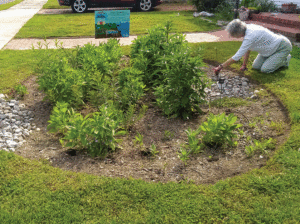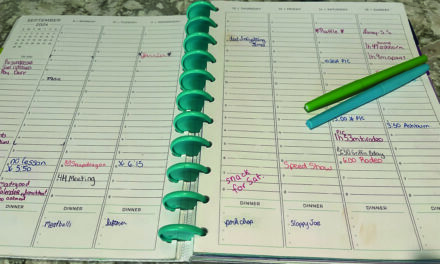
Janet Weeks of Cambridge works in her rain garden installed last year with help from a Chesapeake Bay Foundation and Nanticoke Watershed Alliance grant program. (Photo by Debra R. Messick)
On summer Sunday evenings it may seem to take forever, traveling Route 50 West from Cambridge to the Chesapeake Bay Bridge, but eventually you get there.
The slow, steady drip of cars creeping towards the Bay may be a source of frustration to weekend beach commuters.
But to those concerned with tainted stormwater runoff from Cambridge roofs, streets, and other impermeable surfaces ultimately to the beleaguered Bay, slow and steady is just the way they like it. Among them are the Chesapeake Bay Foundation, Nanticoke Watershed Alliance and a variety of other vital conservation groups, plus municipal governments seeking solutions as well as ways to meet mandatory regulation compliance.
There’s good news — the Chesapeake Bay Cleanup plan, set forth in the landmark 2014 signing of the Chesapeake Bay Watershed Agreement, is recording more success.
Notably, two crucial contributing sectors, agriculture and septic, currently are sending decreasing amounts of contaminants to the Bay, according to Hilary Gibson, Eastern Shore Grassroots Field Specialist for CBF.
But there’s also bad news, and it’s getting worse; the percentage of polluted stormwater runoff is still increasing.
Making sure that existing structures begin to address the issue and ensuring that new developments start off by doing so is critical, Gibson said.
Though state, county, and city governments have been working to comply with regulations aimed at reducing runoff, nonmunicipal property remains outside their jurisdiction, spurring them to incentivize individuals to act on their own.
“With everybody a part of the problem, everybody can be a part of the solution,” Gibson said.
2019 marks the third year of a successful grant program assisting Cambridge homeowners to install rain gardens. Participants selected must reside within the Cambridge city limits, and receive financial aid covering costs plus guidance to maintain the gardens.
Ten garden projects were installed over the first two years; five more will be created this year, and another five next year, confirmed Gibson, who has been instrumental in managing the program courtesy of CBF’s matching contribution to the grant fund received through NWA.
Each spring a workshop has been held offering a limited number of free rain barrels to those showing up on a first come, first served basis.
While there, they also get the run down on the benefits rain gardens can offer for their property and community. The strategy seems to be working.
“Interest has been strong, and turnout great,” Gibson said. For folks living in areas of Dorchester County not covered by the grant, she provides information to follow through on their own.
“All throughout this area, we have issues with really clay soil and we want the water to be able to percolate through the garden and not just sit on top of the clay,” Gibson, a Cambridge resident, explained.
She recalled that for the first year, each homeowners’ soil was lab tested, resulting in a 100-percent finding of clay.
Now contractors typically just excavate, she said. In some cases, permeated pipe is installed below the surface to help ease increased overflow during heavy rain events, taking water farther underground and essentially creating a mini drain field.
An essential feature of rain garden construction includes a direct route from rain gutter downspout to garden.
This can involve PVC pipe, a rock gravel swale, or a nearly invisible French drain where the conveyance from downspout is buried underground and reemerges in the garden, Gibson explained.
The depressed bowl-shaped garden bed is refilled with layers of stone and landscaping fabric, topped off with a bio soil mixture more amendable to drainage.
More local landscaping professionals are acquiring the know-how to help foster best Bay Health practices. Since 2016, Chesapeake Bay Landscape Professional Certification has been offered via the Chesapeake Conservation Landscape Council.
Only native plants, which are naturally hardy and support native wildlife and pollinators, are installed in the gardens.
“That’s where I come in,” added Gibson, who earned a Plant Science degree from the University of Delaware. “I have fun working with homeowners, because there really is a native plant for everything. If they especially like birds and butterflies you can plant flowers to attract them; there are also shade plants, all kinds of beautiful trees and shrubs. We try to make sure homeowners add to their particular yard ambiance along with helping solve the runoff problem.”
The Native Plant List published by the University of Maryland’s Extension Service (Home and Garden Publication #120) offers suggestions, but it’s crucial to choose plants that can tolerate “wet feet” for a period of time, yet also withstand the drought periods in August, Gibson mentioned.
Working with the Master Gardeners she follows up each year evaluating “what survived, what’s thriving, and what’s not doing well,” to most effectively plan future gardens for Dorchester County, specifically.
Several extreme storm events occurred the first year, pummeling the gardens with rain just as they were getting established, and definitely “putting them to work,” Gibson remembered.
That year, especially, evaluating them was “a bit tricky,” but helped lay the groundwork for the decision, going forward, to plant native grasses with densely thick root systems close to where the water enters the garden.
A bit ironically, rain gardens do best when set up to receive full sun throughout the day.
This surprised Janet Weeks, who was sure her often soggy shaded back yard would be a more logical spot.
Weeks, a recent Baltimore area transplant to Cambridge’s West End neighborhood located close to the Choptank River, had a rain garden installed by the group last year in her sun soaked front yard.
Having contributed 20 percent (about $200, she estimated) towards the set-up cost, Weeks was thrilled when the relatively low maintenance project’s perennial native plants returned this year, right on schedule.
“It all came back,” she happily declared, pointing out Milkweed, Coneflower, and Black-Eyed Susan, among others. “I get so many compliments,” she added.
She also got enthusiastic garden help from then 7-year-old granddaughter Charlotte whenever she visited.
Weeks said she and several neighborhood friends decided to attend the March 2018 workshop, attracted mainly by the chance to bring home a free rain barrel. But after learning about the rain gardens she was “first in line” to sign up.
Along with the garden, Weeks’ free rain barrel from the workshop was also installed.
It stays covered, receiving its precious hold of captured precipitation via a short piece of pipe accessing a rain gutter, doing its small part helping detour just a little more Cambridge roof run off, keeping it here on the Shore instead of the Bay.
For more information about the Cambridge Rain Garden program, contact Gibson at 410-543-1999 or hgibson@cbf.org.
Homeowners seeking a certified landscaper can check the directory by visiting https://certified.cblpro.org/.




